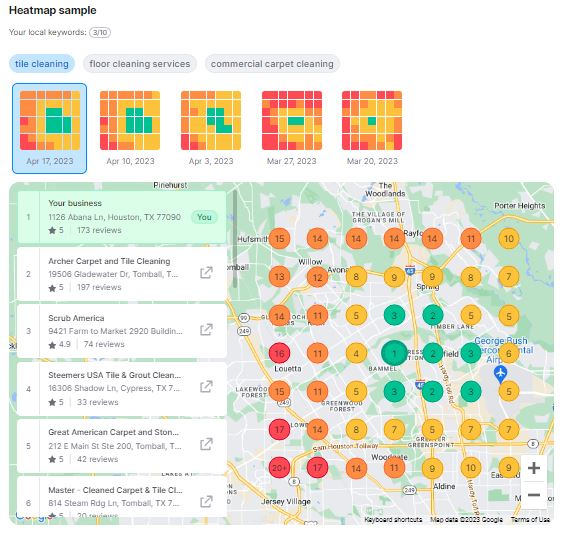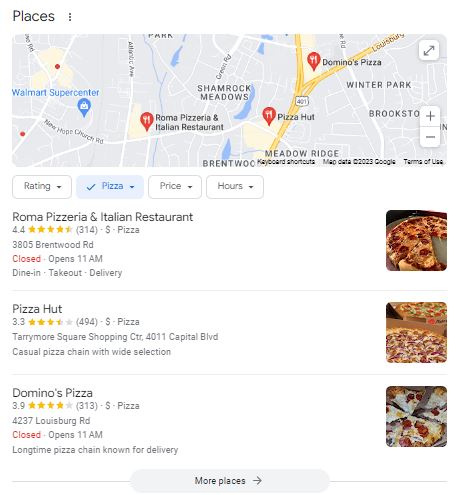
Do you want the keys to unlock success with your virtual storefront? It’s time to embrace the local revolution that’s reshaping the way customers find and engage with businesses like yours. Local SEO strategies for ecommerce are the secret weapon that fuels this transformation, enabling you to:
- Elevate your brand awareness.
- Capture valuable leads.
- Send consumers straight to your online or offline stores with just a few taps on their mobile devices.
Picture this: Your website is flawlessly optimized for local searches, attracting floods of eager customers to your storefront.
Google, the ultimate gatekeeper of search results, holds the key to this opportunity.
Are you ready to rise above the rest? Whether you’re new to local SEO or looking to refine your existing approach, this guide will serve as a valuable resource to help you navigate the complex world of local SEO strategies for ecommerce websites.
Let’s embark on this adventure together with this comprehensive blog, including topics like:
- Importance of local SEO for ecommerce businesses
- Local SEO basics
- Local SEO strategies for ecommerce: 8 key factors
- Optimizing your Google My Business profile for local SEO
- Importance of NAP citations
- Getting more reviews
- Monitoring & optimizing your local SEO strategies
- Local SEO strategies for ecommerce: Frequently asked questions
Importance of Local SEO Strategies for Ecommerce Businesses
Nearly half of Google searches are conducted with local intent, indicating a strong demand for websites that are optimized for local searches.
For ecommerce businesses, local SEO plays a crucial role in attracting potential customers and increasing brand visibility within a specific geographic area.
72% of consumers that did a local search visited a store within five miles.
This highlights the importance of local SEO for ecommerce businesses as it can drive foot traffic to your brick-and-mortar locations, resulting in increased sales and conversions.

Local SEO Basics
Local SEO is the secret sauce that supercharges your ecommerce website for local search.
When it comes to local SEO for ecommerce, it’s important to understand unique challenges like the Google Local Map Pack and the opportunities that you can uncover by optimizing for it. Fortunately, this challenge is attainable by optimizing some key tenets of local SEO.
Some local SEO best practices include:
- Utilize local keywords.
- Set up and optimize your Google My Business profile.
- Capture traffic from mobile searches.
- Build NAP (name, address, phone) citations in local directories.
Check out our Local SEO Checklist for a list of actions you can take.
Now that you know the basics of local SEO, let’s dive into some of the components of how local SEO works.
Local SEO Strategies for Ecommerce: 8 Key Factors
Local SEO works by utilizing various factors to improve the visibility of your website in local search results. These factors include:
- Location
- NAP citations
- Google My Business (Google Business Profile) listing
- Keywords in profile and reviews
- Google Maps star rating
- Check-ins
- Shares on social media
- Local keywords
Let’s dive into each of these factors a bit more.
1. Location

The proximity of a business to the user’s location is an important ranking factor. Google’s algorithm considers the user’s location when displaying local search results.
SEMrush Listing Management and Local Falcon are two tools that help check your local rankings for your location.
2. NAP Citations
NAP is an abbreviation for name, address, and phone number. Maintaining consistent and accurate NAP citations across different online directories and listings assists search engines in verifying the authenticity and location of your business.
It’s extremely important that these are consistent across all the directories, including using the same abbreviations and punctuation (i.e. 123 Main St. vs. 123 Main Street).
Examples of these directories include Yelp, Better Business Bureau, Yellow Pages, and Foursquare.
3. Google My Business (Google Business Profile) Listing
Creating and optimizing a Google My Business (GMB) listing is pivotal for local SEO. It provides important information about your business, such as name, address, phone number, website, and operating hours.
Utilizing your Google Business profile to its full capacity will help you reach more customers for your business.
The best part is that it’s free to set up and easy to maintain. You can learn more about how to set this up here.
4. Keywords in Profile & Reviews
This one is often overlooked. Including relevant keywords in your business profiles and encouraging customers to leave positive reviews that mention these keywords can improve your local search rankings.
You can also respond to reviews and add in relevant keywords if you can organically add them in.
5. Google Maps Star Rating
The star rating given by customers on Google Maps can influence your visibility in local search results. Higher ratings indicate a better user experience and can improve rankings.
Trust is a big component in showing up in search engine results.
By understanding and optimizing these factors, you can increase the chances that your business will appear in the coveted Map Pack and attract local customers.
6. Check-Ins
Check-ins can help with engagement overall and lead to a higher organic search presence. Encouraging customers to check-in to your business location on platforms like Facebook can increase visibility and show social proof to potential customers.
7. Shares on Social Media
Sharing content related to your business on social media platforms is yet another way to increase your visibility, attract local customers, and increase your organic social listing.
8. Local Keywords
One of the most important ranking factors for local SEO is keyword rankings. Choosing the right local keywords and optimizing them effectively can significantly improve the website’s visibility and attract relevant local traffic.
Tying all these eight factors together is the start to understanding what contributes to good rankings. We’ll zero in on a few of the factors in the next section.

Understanding Google’s Ranking Factors for Your Local SEO Strategy
Two critical facets of local SEO that are important to understand are Map Pack ranking factors and the significance of local organic results.
While the Map Pack holds considerable importance, equal attention must be devoted to local organic results, as they provide relevant and valuable information to users.
To establish a comprehensive local SEO strategy for ecommerce, you must diligently optimize for both Map Pack rankings and local organic results. Embracing this balanced approach is the key to unlocking the full potential of local SEO and reaping its rewards.
Map Pack Ranking Factors

The Map Pack consists of three local business results with a map from Google Maps and is a crucial element in local SEO strategies for ecommerce.
It operates on its own algorithm and has specific ranking factors that contribute to its unique display of local search results.
Three of the most important ranking factors that Google emphasizes are:
- Relevance: This factor assesses how well a local Business Profile aligns with a user’s search query. To enhance relevance, your business should provide comprehensive and detailed information about your offerings. This enables Google to better comprehend your services and match your profile with relevant searches.
- Distance: The distance between the user’s location and potential search results plays a significant role in your local ranking. When users don’t specify a location in their search, Google calculates the distance based on available location data.
- Prominence: This aspect revolves around the level of recognition and reputation of your business. Google considers various factors to determine prominence, including links, articles, and directories. The number and positivity of Google reviews significantly impact local search ranking, alongside the business’s position in search engine results.
Tracking Map Pack Rankings
Benchmarking and monitoring your Map Pack rankings is essential to understand your performance and visibility in local search results, as well as to evaluate your online presence and make adjustments to improve your local SEO strategies.
To facilitate the tracking process, various tools are available, such as SemRush’s Listing Management and Local Falcon. These tools provide detailed insights into specific rankings within the Map Pack, allowing your business to identify trends and patterns.
They help you understand how your rankings vary based on location, providing a comprehensive view of your local SEO performance.
To effectively benchmark and track Map Pack rankings, it’s important to establish a baseline and regularly monitor changes. This allows you to identify any fluctuations in your rankings and take action to optimize your Google My Business profile and other relevant factors.
Importance of Local Organic Results
Local organic results play a significant role in local SEO strategies for ecommerce, as they provide relevant information to users searching for local businesses or services in their area.
While the Map Pack is an important feature, local organic results shouldn’t be ignored.
These results show up below the Map Pack and often include additional details such as website links, customer reviews, and hours of operation. This information helps users make informed decisions about which businesses to engage with.
For ecommerce businesses, local organic results can be valuable to attract potential customers who prefer to shop locally or want to support local businesses.
It’s well worth it for you to optimize your ecommerce website for local SEO and ensure that your information is accurate and up-to-date in order to take advantage of the opportunities provided by local organic results.
Optimizing Your Google My Business Profile for Local SEO
By optimizing your Google My Business (GMB) profile, you can enhance your visibility in local search results and increase your chances of being featured in the coveted Map Pack.
Here are five key steps to optimize your GMB profile:
- Fill out all information accurately and completely, including business name, address, phone number, and website.
- Incorporate relevant keywords in your description and posts.
- Encourage customers to leave reviews, as positive reviews can boost rankings and attract more customers.
- Regularly update information and add new posts to keep the profile fresh and engaging.
- Monitor and fix any incorrect or inconsistent NAP information across various business listings and directories.

Importance of NAP Citations
The accuracy and consistency of NAP (name, address, and phone number) citations across various online directories and local listings plays a key part in enhancing your visibility in local search results, instilling trust in potential customers, and ultimately increasing brand credibility and reputation.
NAP is an essential component of local SEO for both ecommerce businesses and brick-and-mortar locations.
By ensuring that your NAP information is accurate and up-to-date, you can establish a strong online presence and improve your chances of appearing in the Map Pack and local organic rankings.
Building NAP Citations
Building NAP citations across online directories and local listings is important to improve local SEO, as it ensures consistent and accurate business information, which increases visibility and credibility.
To build NAP citations, you should start by listing your business in online directories and local listings.
These directories and listings present chances for businesses to add their NAP information and other pertinent details. It’s important to verify that your NAP information is precise and current, as any disparities can have an adverse effect on local SEO.
Getting More Reviews
To increase credibility and attract more local customers, your business can actively encourage customers to leave reviews, which can boost your online reputation and local SEO rankings. Customer reviews factor into the success of your ecommerce business.
Here are three reasons why getting more reviews is important.
1. Reputation Management
Customer reviews provide valuable insights into your products and services. Positive reviews can enhance the reputation of your ecommerce store, building trust and credibility among potential customers.
On the other hand, negative reviews can harm your brand reputation and deter potential customers from making a purchase. By actively encouraging customers to leave reviews, businesses can manage their online reputation effectively and address negative feedback promptly.
2. Local SEO Rankings
Online reviews are a key ranking factor for local SEO. Google considers the number, quality, and recency of reviews when determining local search rankings. Ecommerce businesses with a higher number of positive reviews are more likely to rank higher in local search results, increasing visibility to local customers.
3. Increased Conversion Rates
Positive customer reviews act as social proof, influencing the purchasing decisions of potential customers. When shoppers see positive reviews from satisfied customers, they’re more likely to trust the business and make a purchase.
By actively encouraging customers to leave reviews, ecommerce businesses can increase conversion rates and generate more revenue.

Local Link Building Strategies
Implementing effective link building strategies can be helpful for businesses looking to establish an online presence and connect with local audiences.
Link building creates a strong network of connections that lead potential customers to your website.
One strategy is to collaborate with local bloggers or influencers who have a strong online presence and a dedicated, local following. By partnering with them, your business can reach a wider audience and gain valuable backlinks.
Another effective strategy is to participate in local events or sponsor local organizations. By getting involved in the community, businesses can build relationships with other local businesses and potentially earn even more backlinks.
Additionally, participating in local events can generate buzz and increase brand visibility.
Creating valuable and shareable content is a powerful link building strategy. By producing informative and engaging content that is relevant to your local audience, your business can attract natural backlinks from other websites and social media platforms.
You should actively monitor your online presence and reach out to websites that mention your business but don’t provide a link. By requesting a link to be added, you can enhance your link profile and improve local SEO for your ecommerce business.
Monitoring & Optimizing Your Local SEO Strategies
Monitoring and optimizing results for local SEO involves analyzing data and adjusting based on the performance of your local SEO strategies. This ensures that you can track your progress and make informed decisions to improve your online visibility and connect with your target audience.
To effectively monitor and optimize local SEO results, you can utilize various SEO tools like SEMrush or ahrefs, among others. These tools provide valuable insights into your website performance, including organic search traffic, keyword rankings, and backlinks.
One important aspect of monitoring and optimizing results is tracking SEO rankings. By regularly monitoring your rankings on search engine result pages (SERPs), you can assess the effectiveness of your local SEO strategies, including identifying which keywords are performing well and which keywords need optimization.
Ecommerce site owners should also monitor organic search traffic. By analyzing the sources of organic traffic and identifying trends, your business can gain valuable insights into your target audience’s behavior and preferences.

Local SEO Strategies for Ecommerce: Frequently Asked Questions
Q: How can I optimize my ecommerce website for local search?
A: To optimize an ecommerce website for local search, focus on local keywords, optimize your Google My Business profile, and build NAP citations. Regularly update your website with relevant information and encourage customers to leave reviews.
Q: What are some effective local link building strategies for ecommerce businesses?
A: Some effective local link building strategies for ecommerce businesses are:
- Create high-quality content that attracts local influencers and bloggers.
- Reach out to local business directories and industry-specific websites for partnerships.
- Leverage social media to connect with local communities and share relevant content.
Q: How can I monitor and optimize my local SEO results for my ecommerce store?
A: Some ways to monitor and optimize local SEO results for your ecommerce store are:
- Track your Map Pack ranking using tools like Local Falcon or Local Viking.
- Optimize your Google My Business profile.
- Build consistent NAP citations.
- Utilize local SEO tools for keyword research and competitor analysis.
Q: What are some best practices for getting more reviews for my ecommerce business?
A: To get more reviews for your ecommerce business, some best practices are:
- Offer incentives for reviews (as long as you don’t specifically ask for positive reviews).
- Send follow-up emails to customers after purchase.
- Provide exceptional customer service.
- Actively engage with customers on social media.
Q: How can I ensure my NAP citations are accurate and consistent for my ecommerce store?
A: To ensure accurate and consistent NAP citations for your ecommerce store, it’s important to list your business in online directories and local listings. Regularly monitor and update your NAP information, fixing any incorrect or inconsistent citations that may arise.
Tying It All Together: Local SEO Strategies for Ecommerce
Local SEO strategies are a pivotal aspect of digital marketing for ecommerce businesses. By optimizing your website for local search, you increase your online visibility, attract more traffic, generate leads, and enhance brand awareness.
Understanding the ranking factors used by search engines, such as location, NAP citations, and Google My Business listings, is essential for successful local SEO strategies for ecommerce.
Tracking Map Pack rankings and implementing strategies like building NAP citations, getting more reviews, and local link building can further enhance your results.
Continuous monitoring and optimization are key to achieving long-term success in local SEO. What opportunities are you missing out on without a dedicated team to ensure your success with organic search?
With the SEO experts at ROI Revolution by your side, you can achieve new heights that you didn’t know were possible. To discover the untapped opportunities for profitable growth that we could discover together, send a message to our team today.
Sources
- Search Engine Journal, 71 Mind-Blowing Search Engine Optimization Stats.
- HubSpot, 16 Stats That Prove the Importance of Local SEO.
- SEMRush, Local Keyword Research for SEO: What It Is & How to Do It.
- Google Business Profile, How to improve your local ranking on Google.
- Search Engine Journal, Why NAP & User Experience Are Crucial To Local SEO.




